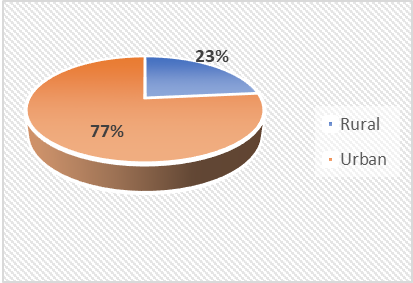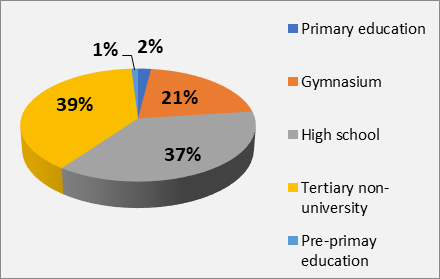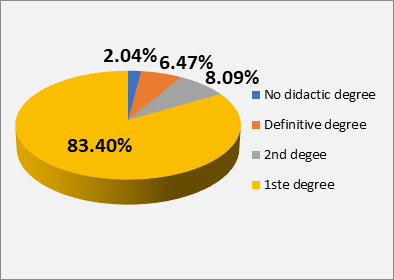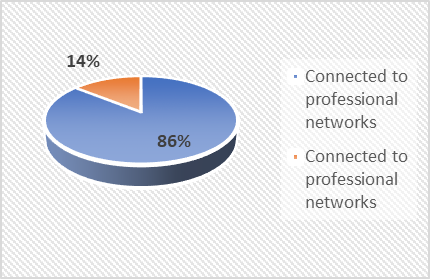Abstract
The present study is carried out at national level by a research team from the University of Bucharest within the framework of the international project Scientix, coordinated by European Schoolnet and the activities undertaken by the National Community for Science Education. The conceptual framework of the research is based on data and information on STEM (science, technology, engineering, and mathematics) education and its context at European and national level. The study addresses the beliefs and attitudes of STEM teachers in the pre-university education on current practices, evolution and trends in the skills of students. Two investigative techniques are used: document analysis and an on-line standardized questionnaire survey. The grid is a standardized tool developed by Friday Institute for Educational Innovation for which we received the agreement to use. So far quantitative data was collected from 252 STEM teachers. The survey invites teachers to give information about: their self-efficacy for teaching; their belief that teachers affect student learning; how often students use technology; how often they use certain STEM instructional practices; their attitudes toward 21st century learning; their attitudes toward teacher leadership; their awareness of STEM careers. For this article we focused on two out of the seven constructs - personal teaching efficacy and beliefs and STEM Instruction. Each of the two constructs are operationalised in eleven, fourteen sub-items respectively. The discussion on the two constructs are quite relevant in light of the relationship between beliefs and practices while the results are quite striking, with impact on tailored professional development approaches.
Keywords: STEM educationbeliefsattitudespersonal self-efficacySTEM instruction
Introduction
The World Competitiveness Report 2015-2016 (World Economic Forum, 2015), which provides an overview of competitiveness in 140 countries, reveals that education reforms must be a key focus of the governments’ agenda to increase the competitiveness of the economy today, an economy based on innovation, technology and entrepreneurship.
Relatively recent studies indicate the main determinations of science education in a formal context (Kearney, 2015). Some synthetic extracts from these materials give us useful information to circumscribe the investigative approach: Recommendations for Educational Policies, material developed in November 2017 within the European TTTNet project (Teamwork, Training and Technology Network); Science, Technology, Engineering and Mathematics Education: A Survey of Challenges in Europe, a booklet published by European Schoolnet in 2011, a starting point for the European Scientix program; ASPIRES - Young people's science and career aspirations, age 10-14, study conducted in the UK in December 2013.
Legitimacy and opportunity of research
The investigative approach was carried out within the framework of the international project Scientix, coordinated at European level by European Schoolnet, constituting a distinct activity within the implementation plan in Romania for the period 2017-2019.
The conceptual framework of the research is based on data and information on STEM training and its context, as evidenced by evaluation reports and recommendations developed in recent years in Europe and at national level. Several featured conclusions justify this investigative approach:
the need for qualified specialists in STEM-related fields to truly support the development of a dynamic and innovative knowledge-based society and economy;
existing initiatives to integrate formal education with institutions, initiatives and resources supporting science education through non-formal approaches; developing and expanding non-formal education programs for STEM;
support networks made up of scientists, researchers and practitioners, through punctual support, directly or indirectly, through citizen science projects, etc.
recent documents on European education recommendations and policies, as well as the increasing allocation of financial resources of funding from the European Commission (2015) for projects to promote, train, and increase the attractiveness of science and science education;
repeated reports in the Romanian public space on the programs and projects carried out or in progress, the focus on the transfer of the results of the scientific research projects and their extension within the educational system;
the existence in Romania of extensive European networks dedicated to teachers and related to different initiatives and projects (eg. Scientix, ESERO, ROEDUSEIS, eTwinning, etc.) emphasizing the need to connect and participate in organizing and developing the system.
Mandate
-
The project team from the University of Bucharest (National Contact Point for Scientix since 2015) elaborated an evaluation research methodology, identified the necessary tools and applied them, and developed the research report. Potential users of the research conclusions: teachers; institutions involved in initial and in-service teacher education processes; national and European institutions interested in research results to perform comparative and system analyzes; funding institutions for specific programs in the field; potential partners in the development of educational programs in the field (research institutes, NGOs, companies); the direct and indirect beneficiaries of the Romanian education system.
Problem Statement
In a number of countries in Europe, STEM education has become a current priority and strategies are developing in order to improve STEM literacy, STEM teaching and learning, as well as the uptake of studies and careers in this area. This is partly due to the following reasons: students low results in science, paired with a growing demand for STEM professionals and provision of pre-service training and in-service training for STEM teachers and of guidance and evaluation tools for school leaders.
In Romania the latest results in PISA as well as at national exams show a decrease in the interest of students in this areas of study, while the results are much below the OECD average.
Research Questions
The research questions revolve around the following topics: which are the beliefs and attitudes of teachers related to their self-efficacy, classroom practices, use of technology, learning results and STEM related careers? Does these attitudes and beliefs explain in any way the actual results of students?
Purpose of the Study
The aim of the investigation is to highlight the extent to which current STEM training practices in pre-university education contribute to the formation and development of STEM students' competencies.
The objectives of the evaluation research are:
O1. Description of the current situation of STEM education in Romania;
O2. Identifying the beliefs and attitudes of teachers about self-efficacy in teaching;
O3. Assessing beliefs about how teacher activity affects student learning;
O4. Assessing the degree of use of technology by students in their learning approach related to STEM disciplines
O5. Identifying teachers' perceptions regarding the application of innovative pedagogues in the training of STEM disciplines;
O6. Assessing your own attitudes about the skills of the 21st century, the leadership skills of the teaching staff
O7. Assessing the awareness of STEM careers.
Research Methods
The investigative strategy is related to the priorities and trends identified in the area of science education, the characteristics of the investigated population and the effective investigation possibilities of the project team. Two investigative techniques are used: document analysis and standardized questionnaire survey to reveal views, underlying values, attitudes and trends in teaching practice, training content, available or needed resources, and the opportunity and the value of STEM education.
Tools
The questionnaire survey was chosen as main research tool in order to reach a significant number of teachers. Teacher questionnaire for STEM subjects was be applied online by a google form. The grids that compose it are standardized tools developed by the Friday Institute for Educational Innovation (2012) and we have the institution's agreement for their use in the present research.
Purpose of the questionnaire was to collect quantitative information to build responses to evaluation questions and test hypothesis research. In the table below there is presented the STEM survey summary as the authors proposed it and the details on each ot the constructs included (Table
The Personal Teaching Efficacy and Beliefs (PTEB) construct and the Teaching Outcome Expectancy Beliefs (TOEB) constructs were derived from a well-known survey of science teachers, the Science Teaching Efficacy Belief Instrument, or the STEBI (Riggs & Enochs, 1990). The Student Technology Use construct was developed from the Student Technology Needs Assessment, or STNA (SERVE Center, 2005). The STEM Instruction construct was based on items that were developed by The Friday Institute and used in a state-wide evaluation of the professional development activities of North Carolina’s Race to the Top grant (Corn, et al., 2013). The 21st century learning attitudes construct was adapted from the Friday Institute’s Student Learning Conditions Survey (2011). Finally, each item in the Teacher Leadership Attitudes construct was taken from the North Carolina Department of Public Instruction’s professional standards for educators (2012).
Sample
The University of Bucharest research team collected data from teachers in the pre-university education system (for this study we only referred to a first round of answers made up by 247 respondents). The details on the characteristics of the groups are presented in the Figure




Findings
For this paper we will only refer to two of the constructs included in the research - Personal Teaching Efficacy and Beliefs and STEM Instruction. Also we led our data analysis on two sub-samples – teachers from primary and preschool education on one side and teachers form secondary education on the other. We considered this approach as the pre-service training for each of the two categories are quite different related to both pedagogical training and specialty training. The preschool and primary teachers are much more skilled in pedagogical approaches while for secondary teachers the specialty competences are better developed. Starting from this reality there can be expressed different premises in analising and interpreting the results. However we interpret the results at this item conservatively as there is a significant difference between the number of teachers in each sub-plot – 57 teachers from pre-secondary education and 190 form secondary education.
The existing research data indicate that STEM education covers a significant proportion of the pre-secondary curriculum, most of the time benefitting of specialised teachers quite certain of their role and aware of the importance of the subject they teach ... mainly in relation with the evaluations and assessments a sutudent runs through this level of education. However, teachers at this level are not ussualy aware of the impact STEM education has on studets’ lives and further social and professional success. For them STEM education is not regarded as high priority in order to enhance students’ achievements beyond the classroom. The same researches tried to identify the possible causes of this state of facts related to the teaching process, still the system of teachers beliefs and attitudes have gone most of the times neglected in relation to the behavior patterns which affect STEM teaching. Why is it relevant to scrutinize teacher beliefs? Contrary to common opinion people don't collect information from the outside world to form new beliefs, but rather they gather new information to support their already existing beliefs. So when aiming at changing teaching practices one should research the beliefs and attitudes supporting the existing ones. The beliefs in the purpose of STEM impact positively or negatively on teachers’ attitudes toward science teaching. Generally, attitudes can be considered a part of people’s belief systems and both attitudes and beliefs relate to behaviour. Teachers with positive beliefs regarding the purpose of STEM education that positively assesses her/ his ability to teach STEM (belief) will develop a keen pleasure in teaching STEM classes (attitude). The result is a teacher who develops her/ his teaching practice (behaviour). This strong interrelationship of beliefs, attitudes, and behaviour shows why it is therefore important to understand each of the components and the relationship between them.
On the other hand at both primary and secondary level we believe that there are other challenges that relate to teachers beliefs, attitudes and behaviours that in the end impact students’ learning process. Although the recent interest in STEM education has been proved by the educational policies as well as the contribution of other relevant stakeholders, the implementation of more complex instructional strategies related to the domain faces several challenges starting with more insight on the learning results and their impact on personal, professional and social success of students. First of all, to effectively implement STEM of impact, teachers must develop extensive knowledge of the content that they teach in line with the developments in the scientific field and in line with the present individual and socio-economic needs (STEM content knowledge), but also with the psycho-pedagogical characteristics and interests of the new generations (pedagogical knowledge). This calls for a strong commitment to professional learning and development. Second, STEM education might raise issues related to financial support as it often requires significant resources for students. Teachers appreciate the provision of laboratories, relevant toolkits and materials to help them teach STEM. Consequently, the research on teachers’ beliefs and attitudes towards STEM teaching, their openness and motivation to change their beliefs and behaviour in order to impact students’ learning, should become centre of interest.
In line with the research conclusions from other studies we will discuss some of the data derived from our investigation. Related to the first construct Personal Teaching Efficacy and Beliefs – we can see that in general teachers have a good, positive belief regarding their personal teaching efficacy. In all cases the Agree/ Strongly agree is over 86% with a single exception I wonder if I have the necessary skills to teach science, the only item that is negatively worded. All other items are positively worded. For this item the scores are Agree/ Strongly agree (48.98%), Disagree/ Strongly disagree (36.84%) and Neither Agree nor Disagree (14.18%). We interpret the results at this item conservatively however it is important to notice the differences between the two subplots – the pre-secondary teachers seem to be reserved towards their skills to teach science (66.66% - Agree/ Strongly agree), while only 43.68% of the secondary teachers doubting this skills. The results in this item are supported by those to I am confident that I can explain to students why science experiments work (91.22% - agree/ strongly agree for pre-secondary teachers and 97.36% - agree/ strongly agree for secondary teachers) and I am confident that I can answer students’ science questions (89.47% - agree/ strongly agree for pre-secondary teachers and 98.94% - agree/ strongly agree for secondary teachers). Interestingly enough the scores change quite significant with greater percentage in favour of pre-secondary teachers in the case of the item related to students’ motivation I know what to do to increase student interest in science (96.49% - agree/ strongly agree for pre-secondary teachers and 91.57% - agree/ strongly agree for secondary teachers). (Table
However we cannot feel but a little puzzled by the results at this construct. However it is in line with the results of the OECD TALIS report (2013) based on teachers’ beliefs, perceptions and opinions which concludes that teachers in Romania and Malaysia feel the best trained among teachers in 33 countries, both in the content of teaching and in pedagogy. The last places are Finland and Japan, where teachers feel the least trained. However, the teachers' opinion about their professional training contrasts strongly with the results obtained by the students in another test organized by the OECD: PISA tests show that Romania ranks 45 out of 65, Malaysia on 52, while Finnish students are 12 and Japanese students ranked 7th.
The second construct chosen for this paper mirrors the instructional practices in the classroom. Although the practices/ methodologies reflected by the items are among those reinforced by present research in the field as having an impact in the development of the learning results envisioned for the STEM area, teachers’ responses reflect a different reality. Only Work in small groups exceeded 50% - Usually/ Every time and that because pre-secondary teachers seem to use this method quite frequently 68.42%. Another general remark on the results as a whole for this construct is that most of the times there is a smaller gap between Never/ Occasionally and Usually/ Every time, which proves that the population of teachers is quite biased regarding the practices in the classroom. The last general remark relates to the first item Develop problem-solving skills through investigations where 49.79% of teachers state that they never or only occasionally use this method although the investigation competence is in the first three positions in all STEM syllabuses.
Taking a look at the results related to the two subplots there are some interesting data that should be discussed. For pre-secondary education the first three methods that are mostly used are: Work in small groups (68.42% - Usually/ Every time), Engage in content-driven dialogue (52.63% - Usually/ Every time) and Complete activities with a real-world context (50.87% - Usually/ Every time). Interestingly enough for secondary teachers the first two methods are the same though with significant lower percentage: Work in small groups (45.78% - Usually/ Every time), Engage in content-driven dialogue (43.68% - Usually/ Every time) and Choose the most appropriate methods to express results and Reason quantitatively (with the same value 42.63% - Usually/ Every time). However the first two methods is easy to see that they are not necessary specific to STEM education, while having a more cross-curricular character and unstructured character. On the other hand the method less used in both pre-secondary and secondary education seems to be Recognize patterns in data (with 56.14% of pre-secondary teachers stating that they never/ occasionally use it, while 54.73% of secondary education state the same). Another methodology that seems to be less adopted in the classroom is Create reasonable explanations of results of an experiment or investigation (45.34% of all teachers state that they never/ occasionally use it). However in this case it is interesting to notice the difference in the two subplots as 45.61% of pre-secondary teachers state that they ussualy/ every time use it while only 33.15% of the secondary teachers state the same. Interestingly enough there is a significant difference in using Make predictions that can be tested where 47.36% of pre-secondary teachers confirm to use usually/ Every time, but only 39.47% from secondary teachers seem to use (Table
Conclusion
The development of a solid, relevant scientific understanding of pre-university school students, as well as their preparation to face the challenges of an increasing technical world, requires a exposure to specific teaching practices, beliefs and attitudes demonstrated by STEM teachers. The teachers are key agents so they should promote high self-efficacy and learning outcomes expectancy, engage in challenging but also of impact practices, well aware of the 21st century skills and the future career in the field. The present research focuses only a subset of data from the whole research which is still undergoing, but the data seems promising and revealing. Two main conclusions can be formulated at this time:
Teachers have a high regard on their Teaching Efficacy and Beliefs related to STEM disciplines. The profile of the teachers involved in reasearch covers self-confidence in both their specific domain and pedagogic knowledge and skills, focused on continually improving their STEM teaching practice. They can explain and support students efforts in understanding STEM subjects and welcome their questions. Also they are very welcoming towards other colleagues in sharing their practices.
Teachers are less confortable to use methodologies that are more STEM specific than others. Work goups and Engage in content-driven dialogue which led more to theoretical approaches are the most encountered strategies, while Recognize patterns in data and Develop problem-solving skills through investigations are the least used methodologies of instruction.
Results – the patterns and themes found when the report is completed – can be used to decide to take new action in designing support services for teachers; improvement of training programs in action; understanding the results of students and their motivation towards STEM areas and professions.
Acknowledgments
The authors would like to thank to Scientix RoNCP team, in particular to Dr. Bogdan Popovici (IFIN-HH), for creating the framework for the research, as well as to Scientix Ambassadors who helped in disseminating the call for completing the research tools.
References
- Corn, J., Bryant, L., Maxfield, J., Walton, M., Patel, R., Weiss, S. P., ... & Marks, J. (2013). Second Annual Race to the Top Professional Development Evaluation Report: Part II Local Outcomes Baseline Study. Raleigh, NC: Friday Institute for Educational Innovation, North Carolina State University. Available from http://cerenc.org
- European Schoolnet (2011). Science, Technology, Engineering and Mathematics Education: Overcoming challenges in Europe.
- Friday Institute for Educational Innovation (2012). Teacher Efficacy and Beliefs toward STEM Survey. Raleigh, NC: Author.
- Kearney, C. (2015). Efforts to increase students’ interest in pursuing STEM studies and careers: National Measures taken by 30 Countries – 2015 Report. Available: http://www.eun.org/publications /detail?publicationID=783Koballa, T. R. & Crawley, F. E. (1985). The influence of attitude on science teaching and learning. School Science and Mathematics, 85(3), 222-232
- World Economic Forum (2015). ‘The Global Competitiveness Report 2015–2016’. Retrieved from http://www3.weforum.org/docs/gcr/2015-2016/Global_Competitiveness_Report_2015-2016.pdf
Copyright information

This work is licensed under a Creative Commons Attribution-NonCommercial-NoDerivatives 4.0 International License.
About this article
Publication Date
15 August 2019
Article Doi
eBook ISBN
978-1-80296-066-2
Publisher
Future Academy
Volume
67
Print ISBN (optional)
-
Edition Number
1st Edition
Pages
1-2235
Subjects
Educational strategies,teacher education, educational policy, organization of education, management of education, teacher training
Cite this article as:
Anca*, P., & Cosmina, M. (2019). Stem Teacher Beliefs On Self-Efficacy And Revelant Practices. In E. Soare, & C. Langa (Eds.), Education Facing Contemporary World Issues, vol 67. European Proceedings of Social and Behavioural Sciences (pp. 2166-2175). Future Academy. https://doi.org/10.15405/epsbs.2019.08.03.269
